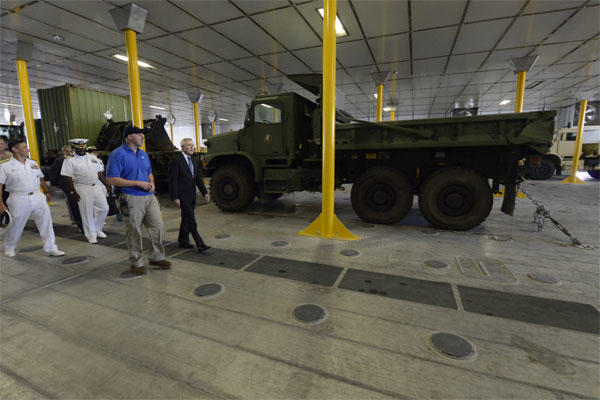BALTIMORE -- The U.S. Navy's second joint high-speed vessel entered Baltimore's Inner Harbor Sept. 10 with other Navy ships to celebrate the Star-Spangled Spectacular, the 200th anniversary of the poem penned by Francis Scott Key that later became the national anthem.
USNS Choctaw County (JHSV 2) sailed from Joint Expeditionary Base Little Creek-Fort Story, Virginia, and hosted Secretary of the Navy Ray Mabus and other distinguished guests for the last leg of the voyage.
"The fact that Choctaw County is going to be one of the representatives of the Navy, showing the people of Baltimore and the people of America the new capabilities, showing them just how good our ships and our MSC mariners and our Sailors and Marines are, I think it's going to be wonderful," said Mabus.
The ship's 20,000-square foot mission bay holds a Riverine Patrol Boat, land-based vehicles, a diving chamber and a variety of other displays from Naval Expeditionary Combat Command, the U.S. Marine Corps and the U.S. Coast Guard. These displays will be open to the public and media Sept. 11-14, noon to 5 p.m.
Choctaw County will also host 189 service members and their families, courtesy of the USO, to watch Saturday night's concert and fireworks from the ship.
Joint high-speed vessels are fast, flexible and maneuverable, and the planned class of 10 ships is designed to enable rapid intra-theater transport.
Mission bay spaces can quickly be reconfigured for multiple mission types, from humanitarian aid and disaster relief to safely delivering vehicles and personnel. The flight deck is certified for aircraft up to and including a CH-53 Super Stallion.
Although the ship's designated mission is for high-speed transport - 1,200 nautical miles at an average of 35 knots - other possible capabilities and missions are being explored for the JHSV class. These might include theater security cooperation, non-combatant evacuations and counter-illicit trafficking detection and monitoring.
The joint high-speed vessel class "brings all sorts of capabilities," said Mabus. "So it's one of these game-changing technologies and it's going to be important for a long time for the Navy."


























